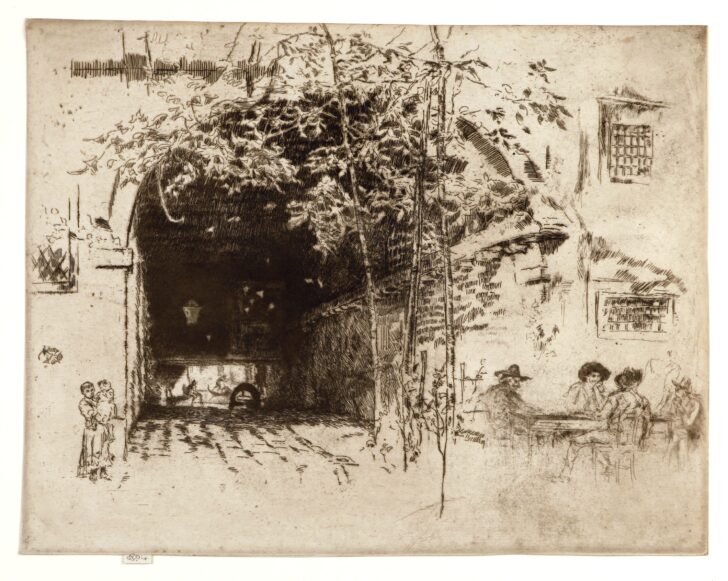The Traghetto, No. 2, One of the ‘Twelve Etchings,’ or the ‘First Venice Set’
James Abbott McNeill Whistler

Description
The Traghetto, No. 1
1879–80
Etching
Second state of three (Kennedy 190)
Bequest of Margaret Watson Parker, 1954/1.376
The Traghetto, No. 2, from Twelve Etchings, or the
First Venice Set
1879–80
Etching
Fifth state of six (Kennedy 191)
Bequest of Margaret Watson Parker, 1954/1.377
Whistler’s image of a ferry landing at the end of a dark passageway of the Ca’ da Mosto proved to be an instance when he ruined his copper plate at the urging of another artist, a “duffer,” according to Whistler, who complained that his first plate looked incomplete. Another colleague, Otto Bacher (1856–1909) tells of seeing a “glorious proof” impression of the first state of The Traghetto, pinned to the wall in Whistler’s room as a reference for further work on the plate. When he was shown the second and third states, he was stunned: the silvery delicacy of the benchmark impression had been ruined by subsequent work on the plate. Reading in Bacher’s face confirmation of his own fears, Whistler bitterly abandoned this first plate. He was able to salvage the composition by transferring the image to a new plate and beginning again; the second plate became known as The Traghetto, No. 2.
Although The Traghetto, No. 1 was one of the first plates Whistler began in Venice, The Traghetto, No. 2 was the last to be completed of the First Venice Set. Indeed, as the invitations to the Fine Art Society’s opening show of the prints had been sent out, Whistler continued to work on the plate. The printer Thomas R. Way (1861–1913), who was with Whistler in London as he continued to fret over The Traghetto, No. 2, described how, “he obtained the silvery quality he wanted, and the lantern with its reflected light at the end of the dark archway, and the leaves falling from the little trees in front—just in time.”
Mrs. Parker obtained one of the very few proofs of Traghetto, No. 1 (albeit a second, not a first state), as well as an impression from the final plate that was shown at the Fine Art Society. Although UMMA’s Traghetto, No. 1 is a second state impression, it retains some of the elusive silvery quality that Whistler was seeking.
Subject Matter:
Otto Henry Bacher saw Whistler working on the "Traghetto, No. 1", one of the earliest subjects Whistler drew in Venice. Whistler was dissatisfied with the progress of the plate and began the composition again on another copper plate; it is this second plate that was included in the "First Venice Set." The Glasgow catalogue raisonné identifies the site as the courtyard of the C'da Mosto, north of the Rialto bridge.
Physical Description:
A dark passageway dominates the middle and left portions of the composition; to the right is a group of men seated outside at a table. The passageway has a view at the far end of a man seated while a gondola passes by. In front of the passageway are three young trees, the leaves of which fall in front of the passageway. To the left of the passageway is a child holding a baby. On either side of the passageway are windows that indicate the walls that fill the plate.
Usage Rights:
If you are interested in using an image for a publication, please visit https://umma.umich.edu/request-image/ for more information and to fill out the online Image Rights and Reproductions Request Form.